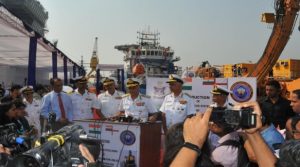
Indian Navy’s first flyaway Deep Sea Submarine Rescue System was formally inducted by Admiral Sunil Lanba, Chairman Chiefs of Staff Committee and Chief of the Naval Staff, at the Naval Dockyard, Mumbai on Wednesday.
The Indian Navy currently operates submarines of the Sindhughosh, Shishumar, Kalvari Classes as well as nuclear powered submarines. The operating medium and the nature of operations undertaken by submarines expose them to high degree of inherent risk. In such an eventuality, traditional methods of search and rescue at sea are ineffective for a disabled submarine.
To overcome this capability gap the Navy has acquired a third generation, advanced Submarine Rescue System considering of a Non-tethered Deep Submergence Rescue Vehicle (DSRV) and its associated equipment.
The Indian Navy now joins a select league of Nations worldwide with the sovereign capability, in fly away configuration, to search, locate and rescue crew from a disabled Submarine. The Deep Sea rescue system would have a global footprint and can be mobilised from the Naval base at Mumbai to the nearest mobilisation port by air/land or sea to provide rapid rescue to the Submarines in distress. The newly acquired capability would be operated and deployed by the crew of Indian Navy’s newly formed Submarine Rescue Unit (West) from its base in Mumbai.
The Indian Navy’s Deep Sea Submarine Rescue System considered to be the most advanced system currently in operation globally, is capable of undertaking rescue from a disabled Submarine upto 650 m depth. The DSRV, which is operated by a crew of three, can rescue 14 personnel from a disabled Submarine at one time and can operate in extreme sea conditions (upto Sea State 6).












